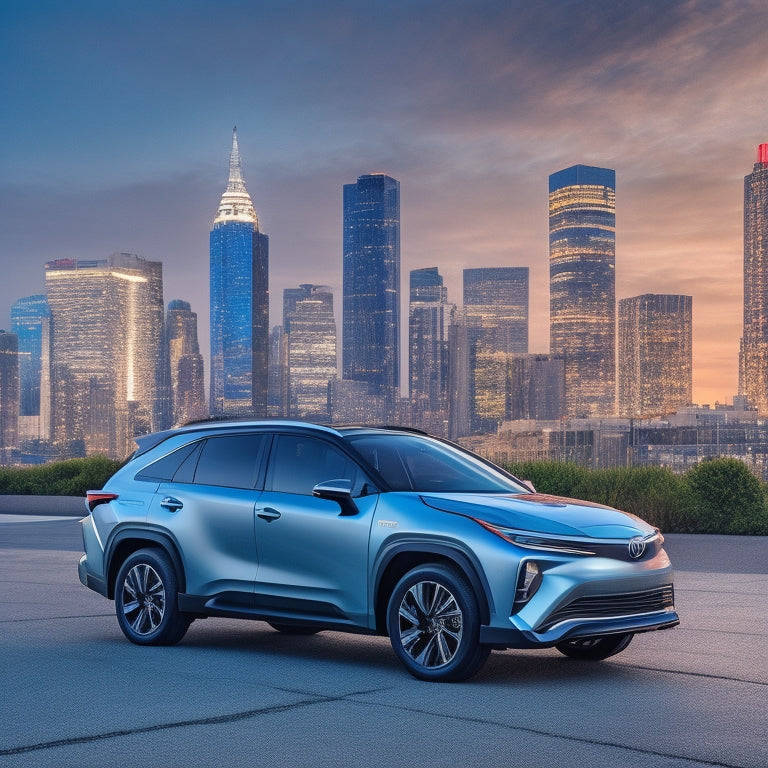
Toyota Introduces Electric SUV Lineup; Charging Guide
Share
Toyota has officially entered the electric vehicle market with its debut SUV, the bZ4X, offering a 250-mile range, advanced safety features, and premium comfort amenities. This marks a significant step towards a more sustainable future, benefiting from reduced emissions, lower costs, and a smooth ride. To support its electric lineup, understanding EV charging basics is essential, with three primary methods: Level 1, Level 2, and Quick Charging. Additionally, finding charging stations near you is easier than ever, with expanding infrastructure and accessibility through navigation systems and mobile apps. Explore further to discover more about Toyota's electric SUV lineup and charging guide.
Key Takeaways
• Toyota's debut electric vehicle, the bZ4X SUV, offers a 250-mile range and advanced safety technology for a sustainable driving experience.
• The bZ4X provides a spacious interior, lower operating costs, and a quieter ride, alleviating range anxiety with its 250-mile range.
• There are three primary charging methods: Level 1 (standard household outlets), Level 2 (faster charging), and Quick Charging (fastest method ideal for long trips).
• Charging stations are easily accessible through navigation systems, mobile apps, and networks like EVgo, Electrify America, and ChargePoint.
• Toyota's electric SUV lineup ensures convenient charging options, with numerous charging solutions available at various locations, including shopping centers and office buildings.
Toyota Electric Vehicle Options
Toyota's initial foray into the electric vehicle market is led by the bZ4X, an all-electric crossover SUV boasting a respectable 250-mile range, comfort-oriented features, and a focus on safety, all while providing plug-and-play convenience.
The Toyota bZ4X features a spacious interior, advanced safety features, and a range that alleviates range anxiety. As an electric SUV, it offers numerous benefits, including reduced emissions, lower operating costs, and a smoother, quieter ride.
With its inventory available, the bZ4X is poised to revolutionize the electric vehicle market. By combining innovative technology with Toyota's commitment to quality, the bZ4X is an attractive option for those seeking a reliable and eco-friendly vehicle.
Electric Vehicle Charging Basics
An in-depth understanding of electric vehicle charging is essential for seamless integration into daily life, and it starts with grasping the basics of charging methods and infrastructure.
There are three primary methods of charging: Level 1, Level 2, and Quick Charging (Level 3). Level 1 charging uses a standard household power outlet, offering a convenient and slow charging speed.
Level 2 charging provides a faster charging speed and may require professional home installation. Quick Charging (Level 3) is the fastest form of recharging, ideal for long road trips.
Understanding these charging methods and their varying speeds will enable you to make informed decisions about your electric vehicle's charging needs.
Finding Charging Stations Near You
As the electric vehicle (EV) infrastructure continues to expand, finding charging stations near you becomes increasingly convenient, with many locations now easily accessible through navigation systems and mobile apps.
The growing charging infrastructure provides urban charging solutions, making it easier to locate stations in metropolitan areas. Major shopping centers, grocery stores, and office buildings often have charging stations, and networks like EVgo, Electrify America, and ChargePoint are continually expanding.
To find a charging station near you, simply use your navigation system or mobile app to locate the nearest station. This convenience is a significant advantage of Toyota's electric SUV lineup, ensuring that you can charge your vehicle whenever and wherever you need to.
Frequently Asked Questions
Can I Charge My Electric Vehicle in the Rain?
Yes, you can charge your electric vehicle in the rain, as charging stations and plugs are designed to be waterproof, ensuring safe and efficient charging on rainy days, eliminating concerns about weather conditions.
How Often Should I Service My Electric Vehicle's Battery?
'An ounce of prevention is worth a pound of cure.' Regular battery checkups are essential for maintaining energy efficiency in electric vehicles, ensuring peak performance and extending lifespan; schedule routine inspections to prevent issues and maximize your EV's battery health.
Are Electric Vehicles More Expensive to Insure Than Gas-Powered Cars?
Electric vehicles may have higher premium rates due to their advanced technology and higher purchase prices, but insurance discounts for eco-friendly vehicles, safe driving records, and bundled policies can help mitigate these costs.
Can I Tow an Electric Vehicle if It Runs Out of Charge?
In the unfortunate event of a drained battery, towing an electric vehicle requires caution; prioritize Tow Safety by utilizing flatbed options to prevent damage to the vehicle's electrical system, ensuring a secure and controlled transportation process.
Do Electric Vehicles Have Less Cargo Space Than Gas-Powered Suvs?
Electric vehicles often have cargo constraints due to battery placement, compromising space efficiency. However, clever design and packaging can mitigate these limitations, resulting in sufficient cargo capacity, as seen in models like the Toyota bZ4X.
Related Posts
-

Why Transform Human Waste Into Garden Gold?
By changing human waste into garden gold, you'll reduce waste management costs, support sustainable agriculture, and ...
-

What Water-Saving Gardens Complement Electric Vehicle Ownership?
As you pair your electric vehicle with a water-saving garden, you're not only reducing your carbon footprint but also...
-

10 Best Sustainable Waste Management Solutions for Green Homes
You're likely unaware that the average green home generates over 2 kilograms of waste daily, but with the right susta...


